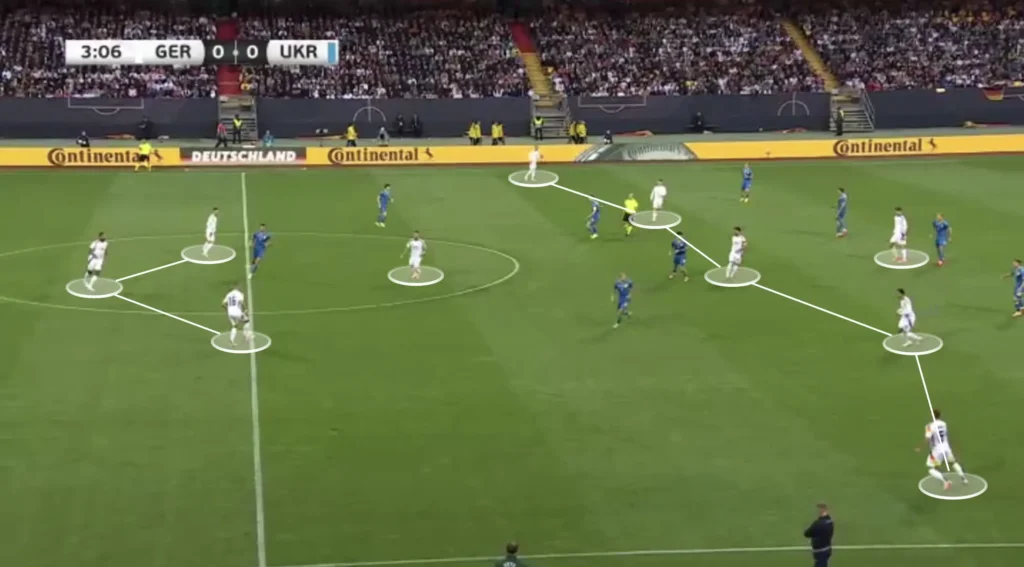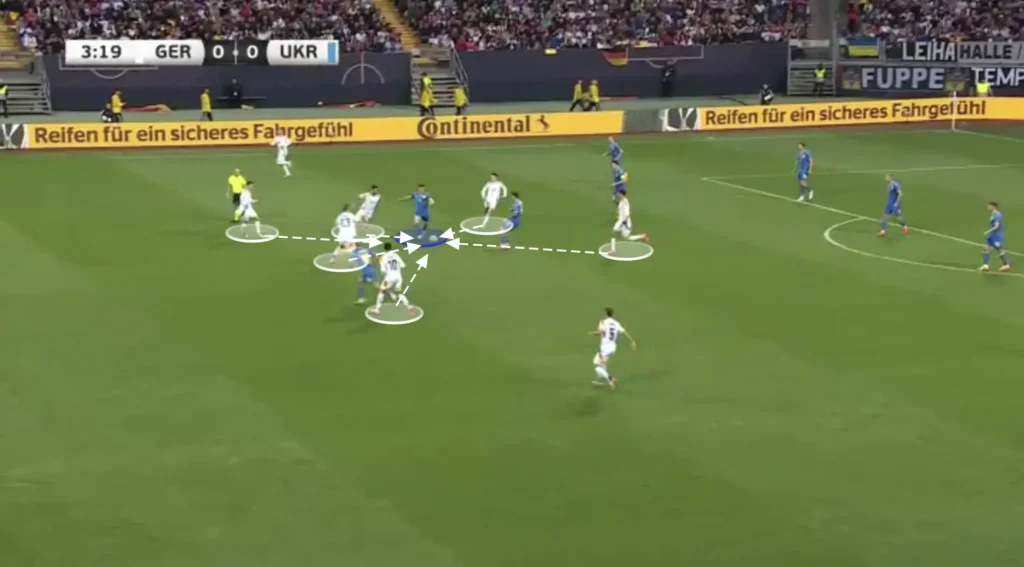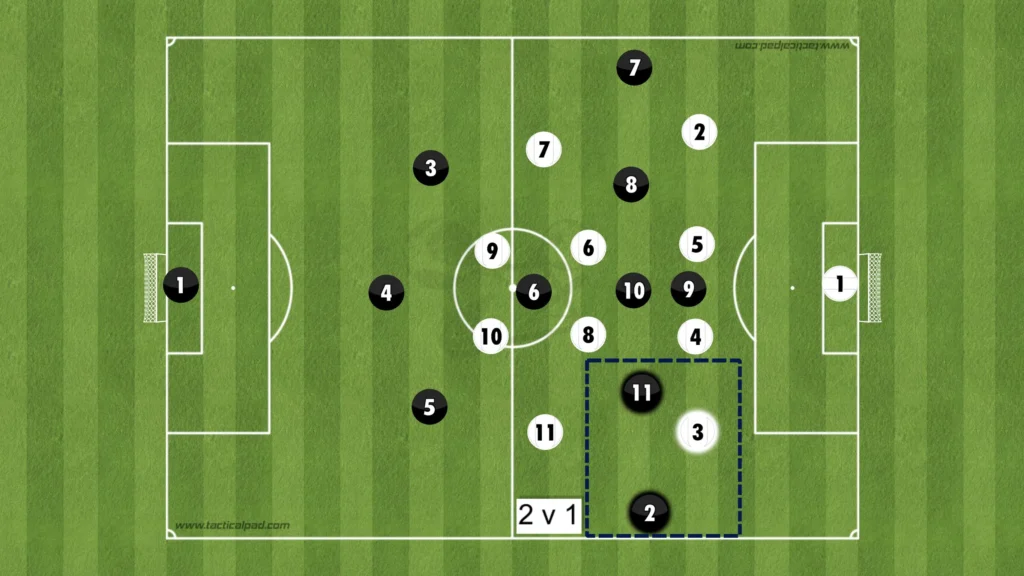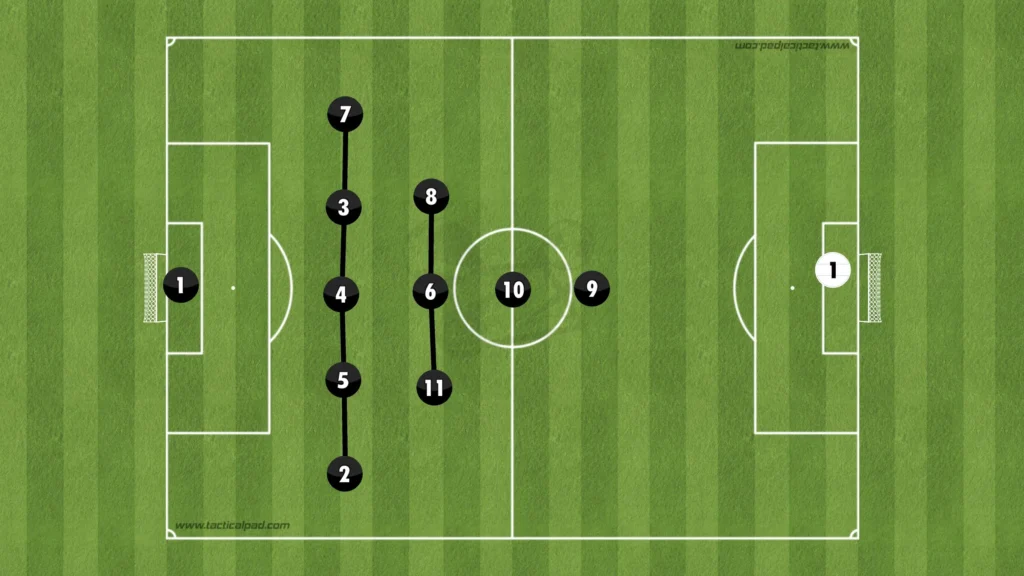Formations are the backbone of football tactics, shaping how teams attack, defend, and control the game. One of the more unique and versatile setups is the 1-3-1-5-1 formation. This modern structure blends midfield dominance and attacking fluidity, offering a dynamic approach to the game.
In this article, we’ll break down the key principles of the 1-3-1-5-1 formation, explore how it works in different phases of play, and highlight why some teams use it to gain a tactical edge. Whether you’re a coach, player, or fan, this analysis will help you understand the strengths and challenges of this innovative setup.
Build-Up in the 1-3-1-5-1 Formation
In the 1-3-1-5-1 formation, the build-up phase focuses on controlled progression from the back, utilizing the back three and the holding midfielder to create a solid base. The three defenders provide width and passing angles, allowing the team to circulate the ball and bypass opposition pressure. The holding midfielder acts as the pivot, dropping deep to receive the ball and link play between defense and midfield.

This formation excels at exploiting central and wide spaces, as the advanced midfielders position themselves between the lines, stretching the opposition vertically and horizontally.
Coaches and Teams Utilizing the 1-3-1-5-1 Formation in Build-Up
Several modern coaches have incorporated the 1-3-1-5-1 formation into their build-up play to create numerical advantages and overloads in key areas of the pitch. Among these are Pep Guardiola’s Manchester City, Julian Nagelsmann’s Germany, and Roberto De Zerbi’s Brighton, each using the setup uniquely to enhance their team’s attacking potential.
Pep Guardiola’s Manchester City
Pep Guardiola’s Manchester City is a masterclass in positional play, and the 1-3-1-5-1 has been a key component of their build-up strategy. Guardiola has often used a back three, with Rodri as the lone pivot in front of them. This structure allows City to dominate possession in midfield, creating overloads between the lines with their advanced players, including attacking midfielders like Kevin De Bruyne and Bernardo Silva.

Julian Nagelsmann’s Germany
Julian Nagelsmann’s Germany has also experimented with the 1-3-1-5-1 to enhance their possession-based style. With a focus on fluidity, Nagelsmann positions his players to exploit central and wide spaces during the build-up. The three defenders ensure stability, while the midfield pivot offers a reliable outlet for recycling possession. The attacking midfielders consistently look to occupy half-spaces, making it difficult for the opposition to maintain defensive organization. This approach underlines Nagelsmann’s commitment to progressive, high-tempo football.

Roberto De Zerbi’s Brighton
Roberto De Zerbi’s Brighton & Hove Albion is another example of the 1-3-1-5-1 in action. De Zerbi’s Brighton was renowned for their patient and structured build-up play. The back three, often composed of ball-playing defenders, allowed Brighton to bypass opposition presses with precise passing. The lone pivot, typically Moisés Caicedo (before his move) or another defensive midfielder, provided both defensive cover and a link to the advanced players.

Numerical Advantage in the Midfield
Teams playing in the 1-3-1-5-1 formation will always have many players in the center. There will be a winger/wingback wide on each side, and the remaining eight players will be in the middle.
Having only the two wingers/wingbacks out wide and the rest in the middle creates more options in the center and less space between the players. Therefore, 1-3-1-5-1 playing teams should prioritize playing through the middle. There will be one player out wide to pull the opposition apart while the rest create numerical advantages in the midfield areas.
When a team outnumbers the opposition in the midfield, it can more easily retain the ball, exploit spaces, and progress the ball through the center. Teams like Pep Guardiola’s Manchester City or Julian Nagelsmann’s Germany will often progress the ball through quick central passes between the midfielders, beating the opposition’s press and exploiting gaps in the defense.
Another purpose for keeping many players in the middle is to shorten the distance between them. This shortens the length of the passes, which naturally shortens the time between passes. This means the opposition players will have less time to push up and press, giving the attacking players more time and control.
Rest-Defence
Rest-defence in the 1-3-1-5-1 formation is crucial for maintaining balance and preventing counterattacks when the team is in possession. Having many players in the middle builds good conditions in defensive transitions, allowing more players to counterpress when losing the ball. The four central midfielders form the core of the rest-defence, as they are well-positioned to deal with any potential loss of the ball.
When losing possession, the four or five players closest should immediately jump on the opposition player with the ball and close the distance to cut off any passing lanes. This approach disrupts the opponent’s transition from defense to attack, forcing errors and creating opportunities to regain control of the ball.

Additionally, when the opposition beats the initial counterpress, there will still be three defenders who can defend against the counterattack. Defending against counterattacks is often easier with a back three because the formation naturally provides more coverage across the width of the pitch. This setup allows one center-back to step forward to challenge the ball carrier, while the other two can provide support or cover the space behind. This added layer of security makes a back three particularly effective in mitigating the dangers of fast transitions from the opposition.
Finding Space in Between the Lines
In a 1-3-1-5-1 formation, the players should always try to find the three attacking midfielders in the pockets. These “pockets” refer to the spaces between the opposition’s defensive and midfield lines, where the attacking midfielders can receive the ball in more advanced positions.

By positioning themselves intelligently in these pockets, the attacking midfielders can turn quickly and face the opposition’s goal, creating opportunities for through balls, driving runs, or direct shots. This positioning forces the opposition to make difficult decisions. If an opposition defender steps up and closes down the attacking midfielder, he potentially leaves space behind. If he stays back, he allows the midfielder time on the ball. The defenders can look for straight or diagonal passes, breaking the opposition lines and finding the attacking midfielders who can turn and drive at the defense.

Finding these pockets is crucial for maintaining fluidity in attack and ensuring that the team can progress the ball effectively through the middle of the pitch.
Finding the Number-ten
The number-ten plays a critical role in the 1-3-1-5-1 formation. Considering his advanced position, he will be the main person to find in the build-up. With the striker pinning the opposition center-backs, the number-ten will often be able to turn when receiving the ball. When he gets the ball, he will be behind the opposition’s midfield, allowing him to drive at the defense and play decisive through-balls to the strikers.
Free player on the diagonal
Because of the danger of letting the number-ten receive the ball, many teams try to close that player off as much as possible. This opens the space for a different midfielder, usually the far-side attacking midfielder.
Here, Man City are building up in the 1-3-1-5-1 formation and have the ball on the left side. Sporting, who are defending, have pushed across to close down spaces on the ball side. This leaves Man City’s far-side attacking midfielder, Rico Lewis, free on the diagonal.

This player can then be found with diagonal passes from the backline.

Dropping Outside
When the opposition defends very compactly and does not allow the attacking midfielders to get the ball in the pockets, the attacking midfielders can drop outside to receive the ball there instead. They should wait for the opposition’s wide midfielders to press the wide center-backs and drop out into the space they left open.

The opposition center-backs and central midfielders rarely follow these runs, not wanting to open the space in the center. Additionally, the winger, who is positioned high and wide, will be pinning the opposition fullback, not allowing him to jump on the dropping attacking midfielder. This means that the attacking midfielder can receive the ball, turn, and progress the ball unopposed.
2v1 Situations Against the Opposition Fullback
In the 1-3-1-5-1 formation, the winger and attacking midfielder can create 2v1 situations against the opposition fullback by coordinating their positioning and movement. The attacking midfielder can drift wide into the half-space to support the winger, drawing the attention of the fullback. Meanwhile, the winger stays wide, forcing the fullback to either commit to one player or leave space for the other to exploit.

These players can often use counter-movements to exploit this numerical advantage. When a wide center-back has the ball, the attacking midfielder can make a run in behind while the winger drops to open the passing lane from the wide center-back.

This creates a question for the opposition fullback. If he steps out on the winger, the space behind him opens up, allowing the center-back to play a through-ball to the attacking midfielder. However, if he stays inside to cover the run, the ball can be played to the winger, who can turn and attack the defense.


Here, the opposition fullback stays inside to cover the run from Brighton’s attacking midfielder, allowing the dropping winger to receive a pass from the wide center-back and take the ball forward.

Attacking the Half-Space
When using the 1-3-1-5-1 formation, a great way to create chances in the final third is to attack the space between the opposition center-back and fullback.

One way to do this is by using an underlap. When the winger receives the ball out wide, he will attract the opposition fullback. This opens the space between the opposition fullback and center-back, which allows the attacking midfielder to make the underlapping run into this space. The winger can play the ball to the underlapping player, who will have the space and time to shoot at goal or find an open teammate in the box with a cross.
Here are two images of Man City’s attacking midfielders doing exactly this:
Additionally, the winger does not have to play the ball to the underlapping player. The run from the attacking midfielder will often drag away an opposition defensive midfielder, which opens the space inside. The winger can take the ball inside and shoot or find a pass to a free player in front of the backline.
Here, Roberto De Zerbi’s Brighton and Julian Nagelsmann’s Germany use this tactic to find the number-ten in between the lines. An attacking midfielder first makes an underlapping run, pulling away an opposition midfielder and opening the passing lane from the winger to the number-ten.
Make the run close to the fullback
An interesting detail about the underlap is that the players usually should make the underlapping run very close to the fullback. The objective of the underlap is to create as big a question as possible for the opposition defenders. If the runner makes the run close to the middle, the opposition center-back or holding midfielder does not have to leave their position much to defend the underlap, which allows them to protect the space in the box and defend the underlap at the same time. However, if the runner, like Kevin De Bruyne does in this case, runs close to the fullback, the center-back or holding midfielder have to leave their position much more to defend the underlap, which opens the space inside.
In other words, the question of whether the opposition defenders should stay in their positions or track the run becomes way bigger if the underlap is made close to the fullback.
Many players high up the pitch
In the 1-3-1-5-1 formation, many players will naturally be high up the pitch in attack. With one striker, three attacking midfielders, and two wingers, there will be seven players very high up who can attack the opposition in the final third.

These players can often create overloads in the opposition’s penalty area in crossing situations.

The overloads in the box increase the chances of connecting with the cross, as more players present multiple targets for the crosser, making it harder for defenders to mark everyone effectively. Additionally, having multiple players in the box provides options for different types of finishes, whether it’s a header, volley, or a quick tap-in. It also allows for better positioning to react to second balls or rebounds, increasing the likelihood of capitalizing on any defensive errors.
Defending in the 1-3-1-5-1 formation
Defending in a 1-3-1-5-1 formation is centered around maintaining compactness and leveraging the numerical strength in midfield. The three center-backs form a solid defensive base, supported by the wingbacks who drop back to create a five-man defensive line when under pressure. The wide attacking midfielders will drop down next to the number-six, while the number-ten stays behind the lone striker. This creates a 1-5-3-1-1 structure.
Defending in the 1-5-3-1-1 formation emphasizes stability and discipline. The five-man defensive line provides excellent width and coverage, making it difficult for opponents to penetrate through wide areas or deliver dangerous crosses. The three central midfielders work closely together to shield the defense, cutting off passing lanes and applying pressure to players in the central areas. This structure is particularly effective at frustrating teams that rely on intricate passing or central overloads, as it ensures compactness and limits the space available for creative play.
Forcing the Opposition to One Side
Teams defending in the 1-5-3-1-1 formation can effectively force the opposition to one side by using the striker and number-ten to initiate the press. The striker should make angled pressing runs, positioning their body to block passing lanes between the opposition’s center-backs, thereby steering the play toward one side of the pitch. The number-ten steps forward to support, applying pressure to the ball carrier while blocking passes into the central midfield.
This coordinated effort forces the opposition into tighter spaces near the sideline, where the defensive midfielders and wingbacks can quickly close down passing options or apply aggressive pressure.
Stopping the switch of play
To stop the opposition from switching sides too often, the players should close all entries to the midfield and force the opposition to switch the play by going all the way back to the center-backs. To do this, the ball-side wingback, ball-side midfielder, number-ten, and striker should form a diagonal line. This diagonal line stops the opposition from going through the middle to switch sides. Instead, they have to go back to the center-backs and, from there, get the ball to the other fullback. This gives the defending team enough time to shift across, allowing them to keep the compact shape.
Counterattacking in the 1-3-1-5-1 Formation
The 1-3-1-5-1/1-5-3-1-1 formation can be challenging for teams to counterattack effectively because of its inherently defensive structure. With five defenders and three central midfielders positioned deep, there are very few gaps for the players to exploit during transitions. The lone striker often lacks the support needed to launch quick counterattacks, as most of the team remains behind the ball to prioritize defensive solidity. This can make it difficult to generate numerical superiority in attacking situations, forcing the team to rely on isolated long balls or individual brilliance to create counterattacking chances.
Final Thoughts
In conclusion, the 1-3-1-5-1 formation is a highly adaptable system that offers both defensive solidity and attacking flexibility. By emphasizing numerical superiority in key areas, this formation enables teams to control the midfield, create overloads against opposition defenses, and apply effective high pressing. However, it requires disciplined positioning, strong technical skills, and excellent understanding among players to maximize its potential.
Whether used for building up from the back, countering opposition presses, or dominating the midfield, the 1-3-1-5-1 formation provides a comprehensive approach to modern football tactics, making it a powerful option for teams aiming to dominate both defensively and offensively.











